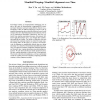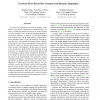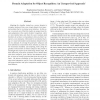AAAI
2012
12 years 5 months ago
2012
The study of transportability aims to identify conditions under which causal information learned from experiments can be reused in a different environment where only passive obser...
AAAI
2012
12 years 5 months ago
2012
Knowledge transfer is computationally challenging, due in part to the curse of dimensionality, compounded by source and target domains expressed using different features (e.g., do...
AAAI
2012
12 years 5 months ago
2012
Relation extraction, the process of converting natural language text into structured knowledge, is increasingly important. Most successful techniques use supervised machine learni...
CVPR
2012
IEEE
12 years 5 months ago
2012
IEEE
In real-world applications of visual recognition, many factors—such as pose, illumination, or image quality—can cause a significant mismatch between the source domain on whic...
KDD
2012
ACM
12 years 5 months ago
2012
ACM
Interdisciplinary collaborations have generated huge impact to society. However, it is often hard for researchers to establish such cross-domain collaborations. What are the patte...
PAMI
2012
12 years 5 months ago
2012
—Cross-domain learning methods have shown promising results by leveraging labeled patterns from the auxiliary domain to learn a robust classifier for the target domain which has ...
CASE
2011
13 years 2 months ago
2011
— Legacy systems that do not conform to the norms and regulations imposed by recent safety standards have to be upgraded to meet safety requirements. In this paper, we describe a...
AAAI
2011
13 years 2 months ago
2011
Transfer learning allows knowledge to be extracted from auxiliary domains and be used to enhance learning in a target domain. For transfer learning to be successful, it is critica...
ICCV
2011
IEEE
13 years 2 months ago
2011
IEEE
Adapting the classifier trained on a source domain to recognize instances from a new target domain is an important problem that is receiving recent attention. In this paper, we p...
ACL
2011
13 years 6 months ago
2011
We consider a semi-supervised setting for domain adaptation where only unlabeled data is available for the target domain. One way to tackle this problem is to train a generative m...



